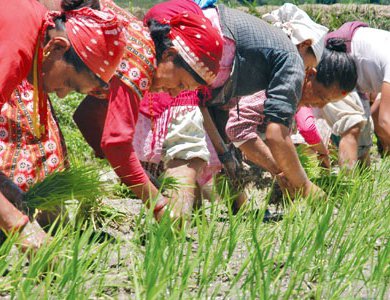
If one looks at the weather forecast data of Department of Hydrology and Meteorology, the chances of a drought in Nepal are rising as the monsoon rainfall this is the lowest in five years.
According to Metrological Forecasting Division of Department of Hydrology and Meteorology, the rainfall in June was record low and in July, it is likely to see a similar situation.
Although the Government is yet to announce its budget, Nepal’s agriculture production is likely to suffer heavily due to the weak monsoon. There is less than 30 percent of rice plantation in terai in place of the 80 percent of last year at the second week of July.
According to Shiva Nepal, senior meteorologist, it will take a few more days to see active monsoon in Nepal. “This year it started late and it is expected that there will be less rain fall this year than previous years.”
In April, meteorologists had predicted the possibility of drought was at 25 percent. Now they are predicting it is likely to be 60 percent.
Monsoon, which accounts for more than 70 percent of the annual rainfall, will be 91 percent of a 41-year average of 89 centimeter (35 inches) this year.
Showers in June were the lowest since 2009, delaying sowing of seeds for crops from corns to lentils and soybeans and threatening to stoke food prices in an estimated 20 million people out of the 28 million population who depend on agriculture for their livelihood and the sector accounts for 14 percent of the nation’s gross domestic product.
“Both acreage and production will be less in many crops,” said agriculture experts. “While domestic stockpiles of rice, pulses and oil seeds wheat and sugar are at lowest levels, there will be problems in coming years.”
Monsoon crops area has declined drastically, 30 percent by June 27, from a year earlier after rains were delayed over most of Nepal, according to Agriculture Ministry. Rainfall in June was 50 percent less than the average between 1951 and 2000, according to Indian Meteorological Department.
El Nino Impact
Even if rainfall returns to normal, it won’t be enough to bridge the deficit. A warming of temperatures in the Pacific Ocean, typically associated with an El Nino, is the main reason for below-average rainfall, department officials said.
The nation may get 93 percent of an average 28 centimeters rain in July and 98 percent each in August and September.
Climate models indicate an El Nino is likely to develop by spring, which starts in September, and there’s a 70 percent chance of the pattern this year, Australia’s Bureau of Meteorology said on July 1.
El Ninos, caused by the periodic warming of the tropical Pacific, occur every two to seven years and are associated with warmer-than-average years. The last El Nino was from 2009 to 2010, and since then the Pacific has either been in its cooler state, called La Nina, or neutral.
As rainfall was below the 50-year average in Nepal, it is likely to reduce food-grain output and double inflation from the previous year.
The seasonal showers are the main source of irrigation for the Nepalese farmers because about 80 percent of crop land is rain dependent. Monsoon rainfall will be 7 percent below average this year as the El Nino emerges, the meteorological department predicts.
As Nepal is aspiring for high growth rate to graduate from Least Developed Countries to the status of developing countries, the low rain fall is likely to cause a major setback for the GDP growth in the coming years.
- FOREIGN EXCHANGE: Largest Deposit
- Jul 22, 2024
- IMF: Approval Of SDR
- Jul 22, 2024
- NEPAL-KOREA RELATIONS: Fifty-Years Of Warm Relations
- May 31, 2024
- NEPAL-BRITAIN: Centenary Celebration
- May 31, 2024
- POLITCS: Forming New Alliances
- May 27, 2024
















